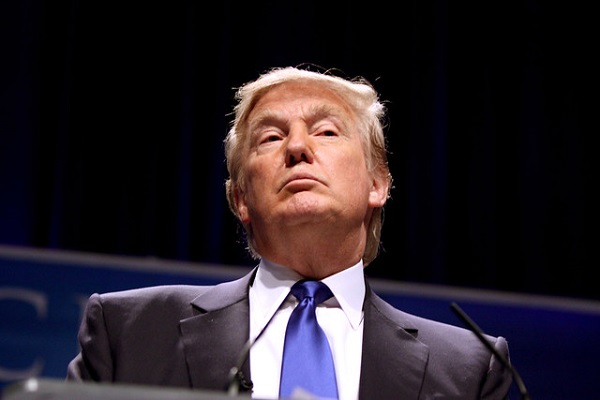
–>
August 13, 2022
At this historical moment, somewhere around half the country remains ready to utter some version of “good riddance” to Donald Trump. And yet, in the not too distant future, a solid majority of Americans may well find themselves thanking Mr. Trump not once, but perhaps three or even four times.
‘); googletag.cmd.push(function () { googletag.display(‘div-gpt-ad-1609268089992-0’); }); }
For starters, he deserves thanks for running and winning in 2016. Secondly, he can be thanked for running and losing in 2020. (Stay tuned on that one.) Then there remains the hope that he soon might be thanked for choosing, Coolidge-like, not to run in 2024 before being slapped on the back a fourth time for supporting the political party that he has played a crucial role in remaking.
That would be the same Republican Party that came into being in the mid-19th century, when Abraham Lincoln’s Whig Party could not be remade. This would also be the same political party that Trump could destroy, if he should choose to abandon it.
All of this presumes that the eventual Republican nominee 1) presides over a big tent GOP that includes Trump constituents; 2) essentially follows Trump policies, domestic and foreign; 3) exhibits a Trumpian willingness to fight; and 4) wins the two terms that Trump did not. After all, it will likely take two full terms of Republican executive and legislative governance to set the country on a course that is at once new and old.
‘); googletag.cmd.push(function () { googletag.display(‘div-gpt-ad-1609270365559-0’); }); }
Such a sustained victory would confirm that the country had finally reversed what President Obama once deemed inevitable — namely, that an “arc of history” is forever bending in the progressive direction of an ever more centralized administrative state. That would be the very state that has been growing in fits and starts for better than a century now.
Such a state has long been in the process of becoming an increasingly secular state. In truth, such a state could only be a secular state. Such a state must also be reversed, but not to impose a state-sponsored religion. Not at all. An increasingly secular people have demanded and will continue to demand an ever more powerful state. A return to religious faith would constitute a return to the vision of the founders, meaning a republic of limited government. Such a republic, said John Adams, is fit for only a religious people.
If such a reversal does occur, Trump might eventually — and ironically — be credited with helping to spark it, not to mention the country’s renewal and revival. To be sure, this reversal will not be without its own fits and starts, since history is always a story of people acting rather than history “arcing.”
There might even be a bipartisan tinge to the whole thing. After all, the original centralizing thrust was initiated by progressives of both major parties. As time went on, the Democrats became the senior partner in this operation, while Republicans were reduced to a supportive role. Wouldn’t it be ironic if the two parties reversed their senior/junior roles as the country reversed its course?
In any case, there is no inevitable “arc” to any nation’s history. Instead, there are choices. If centralized consolidation is a series of choices, as it surely has been, so will be the story of its reversal. For that matter, if decline is a choice, so is a revival. The same goes for choices that the Democrats have made since their sweep (?), such as it was, in 2020.
In 2020, the Democrats won nothing at all comparable to their massive majorities of the 1930s and 1960s that ushered in the New Deal and the Great Society. Nonetheless, in their giddiness at having rid the country of Trump, the Democrats pressed ahead in 2021 as if it were 1933 or 1965 all over again.
‘); googletag.cmd.push(function () { googletag.display(‘div-gpt-ad-1609268078422-0’); }); } if (publir_show_ads) { document.write(“
Let’s not kid ourselves. The senior partner, the Democrat party, has been moving steadily leftward for a good while now — and all thanks to choices, not arcs. The same goes for Democrats’ allies in the media, education, entertainment, and the bureaucracy, as well as large-scale enterprises, best exemplified by the oligarchs of Silicon Valley.
The last named constitute a band of robber barons all their own. In truth, they are much more powerful and much more dangerous than the original “robber barons” of the late 19th century, whose activities and excesses triggered the original progressive movement. Wouldn’t it be deliciously ironic if our modern oligarchs unintentionally spurred a movement in a very different direction?
If such a movement ultimately does succeed, Trump will deserve credit for starting the ball rolling. Whether as candidate or president, Trump fought the arc-minded progressives harder and in ways that the two Bush Republican presidents did not. For that matter, he likely fought them harder than the would-be Dole, McCain, and Romney presidencies would have. He even often fought them harder than Ronald Reagan did. In doing so, he was not just the Democrats’ worst enemy, but his own worst enemy as well.
In the end, Trump played his role so well that he gave the Democrats additional determination to win in 2020, as well as justification to move farther left in the process. But the results of the 2020 election did not indicate that the country has moved dramatically to the left with them. In fact, if President-Elect Biden had a mandate to do anything, it was a negative mandate of sorts: he was simply being asked not to be either Donald Trump or Bernie Sanders.
Instead, with Biden as their party’s figurehead, the Democrats chose to use their slim victory to revive Obama’s arc of history and to demonize those fellow Americans who were once a key democratic constituency in the process.
Isn’t that ironic? What once constituted the voting heart of the New Deal Democrat party, the Northern working class and the solidly solid Democratic South, is now both the object of Democrat animosity and the heart of a remade GOP. What’s doubly ironic is that a nominal Catholic is presiding over a party that has long been abandoning its Catholic base, an abandonment that will no doubt pick up speed as our “devout” Catholic president leads the battle to dismantle the Dobbs decision while legislatively restoring Roe v. Wade.
Given all of this, plus Biden’s sagging poll numbers, Trump must be champing at the bit to run in 2024. If he would run and win, he would be replaying the presidential career of a fellow New Yorker, Grover Cleveland, and his non-consecutive terms. Here’s one more parallel: Trump in 2020 was the first incumbent president since Cleveland to run for re-election, top his original vote total…and lose, as Cleveland did in 1888.
That must grate. Then there is the not so small matter of unfinished business concerning matters such as the border, China, re-restoring energy independence, and continuing to “drain the swamp.”
Adding to Trump’s temptation to run again is the Russia hoax than consumed much of his term, as well as the two impeachments near its end. The prospect of an unhoaxable, unimpeachable second term must be alluring. But it should be resisted — and not just for the good of the country, but for his own good as well.
He should even — nay, he should especially resist the doubly alluring possibility of a rematch with Hillary. After all, a re-elected Trump would be an instant lame duck. And if the country is to return to making a different set of post-progressive choices, well, then a fresh start with a re-electable GOP president would be a good start.
Finally, if Obama’s “arc of history” is to be consigned to the dustbin of history, future generations, including future historians, might well look to the Trump single term in office as the historical point when it all began. Besides, one septuagenarian/octogenarian president at a time should be more than enough for a country somewhere in advanced middle age or beyond. It should also be more than enough for a country in great need of revival — and in many senses of that word.
Beyond all of that, there should be nothing wrong with a little un-Trumpian reticence, a little golf, a lot of Florida sunshine, not to mention the knowledge that one did one’s part in a much larger cause. Just ask Grover Cleveland, who should have been satisfied with his single term. After all, Cleveland’s Democratic Party lost 130 seats in the middle of his second term in 1894.
A similar fate could befall the Democrats in 2022, but don’t tell Trump. It would only encourage him to do what he shouldn’t do come 2024.
John C. “Chuck” Chalberg writes from Bloomington, Minnesota.

Image: Gage Skidmore via Flickr, CC BY-SA 2.0.
<!– if(page_width_onload <= 479) { document.write("
“); googletag.cmd.push(function() { googletag.display(‘div-gpt-ad-1345489840937-4’); }); } –> If you experience technical problems, please write to [email protected]
FOLLOW US ON
<!–
–>
<!– _qoptions={ qacct:”p-9bKF-NgTuSFM6″ }; ![]() –> <!—-> <!– var addthis_share = { email_template: “new_template” } –>
–> <!—-> <!– var addthis_share = { email_template: “new_template” } –>





